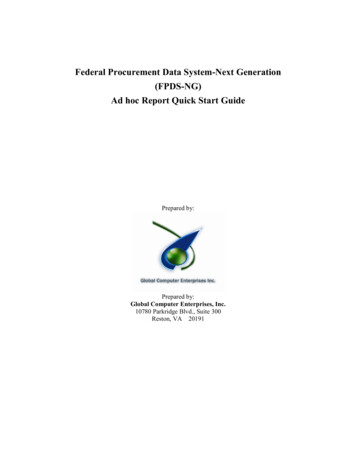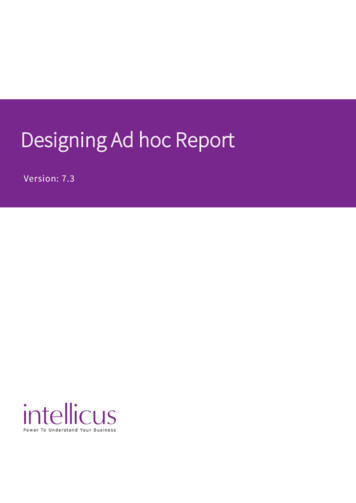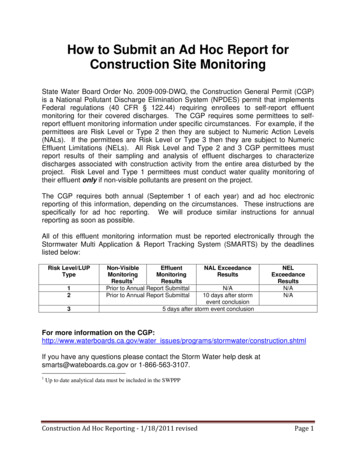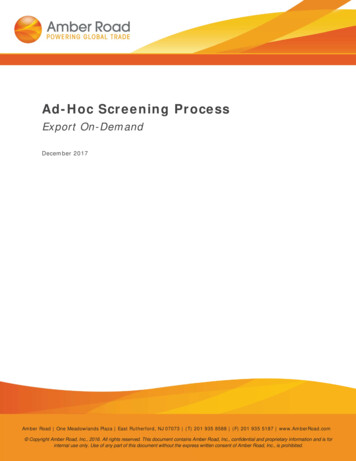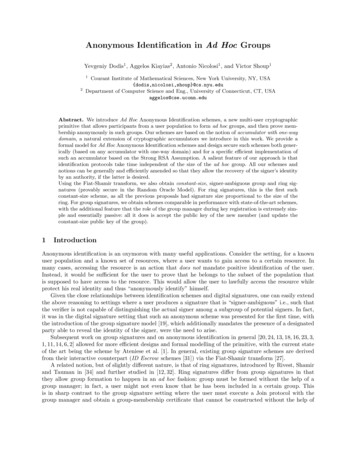
Transcription
Anonymous Identification in Ad Hoc GroupsYevgeniy Dodis1 , Aggelos Kiayias2 , Antonio Nicolosi1 , and Victor Shoup112Courant Institute of Mathematical Sciences, New York University, NY, USA{dodis,nicolosi,shoup}@cs.nyu.eduDepartment of Computer Science and Eng., University of Connecticut, CT, USAaggelos@cse.uconn.eduAbstract. We introduce Ad Hoc Anonymous Identification schemes, a new multi-user cryptographicprimitive that allows participants from a user population to form ad hoc groups, and then prove membership anonymously in such groups. Our schemes are based on the notion of accumulator with one-waydomain, a natural extension of cryptographic accumulators we introduce in this work. We provide aformal model for Ad Hoc Anonymous Identification schemes and design secure such schemes both generically (based on any accumulator with one-way domain) and for a specific efficient implementation ofsuch an accumulator based on the Strong RSA Assumption. A salient feature of our approach is thatidentification protocols take time independent of the size of the ad hoc group. All our schemes andnotions can be generally and efficiently amended so that they allow the recovery of the signer’s identityby an authority, if the latter is desired.Using the Fiat-Shamir transform, we also obtain constant-size, signer-ambiguous group and ring signatures (provably secure in the Random Oracle Model). For ring signatures, this is the first suchconstant-size scheme, as all the previous proposals had signature size proportional to the size of thering. For group signatures, we obtain schemes comparable in performance with state-of-the-art schemes,with the additional feature that the role of the group manager during key registration is extremely simple and essentially passive: all it does is accept the public key of the new member (and update theconstant-size public key of the group).1IntroductionAnonymous identification is an oxymoron with many useful applications. Consider the setting, for a knownuser population and a known set of resources, where a user wants to gain access to a certain resource. Inmany cases, accessing the resource is an action that does not mandate positive identification of the user.Instead, it would be sufficient for the user to prove that he belongs to the subset of the population thatis supposed to have access to the resource. This would allow the user to lawfully access the resource whileprotect his real identity and thus “anonymously identify” himself.Given the close relationships between identification schemes and digital signatures, one can easily extendthe above reasoning to settings where a user produces a signature that is “signer-ambiguous” i.e., such thatthe verifier is not capable of distinguishing the actual signer among a subgroup of potential signers. In fact,it was in the digital signature setting that such an anonymous scheme was presented for the first time, withthe introduction of the group signature model [19], which additionally mandates the presence of a designatedparty able to reveal the identity of the signer, were the need to arise.Subsequent work on group signatures and on anonymous identification in general [20, 24, 13, 18, 16, 23, 3,1, 11, 14, 6, 2] allowed for more efficient designs and formal modelling of the primitive, with the current stateof the art being the scheme by Ateniese et al. [1]. In general, existing group signature schemes are derivedfrom their interactive counterpart (ID Escrow schemes [31]) via the Fiat-Shamir transform [27].A related notion, but of slightly different nature, is that of ring signatures, introduced by Rivest, Shamirand Tauman in [34] and further studied in [12, 32]. Ring signatures differ from group signatures in thatthey allow group formation to happen in an ad hoc fashion: group must be formed without the help of agroup manager; in fact, a user might not even know that he has been included in a certain group. Thisis in sharp contrast to the group signature setting where the user must execute a Join protocol with thegroup manager and obtain a group-membership certificate that cannot be constructed without the help of
the group manager. Note that ad hoc group formation in the context of ring signatures is always understoodwithin the context of a user population and an associated PKI. Based on the PKI, ad hoc subsets of the userpopulation can be formed without the help of a “subset manager”—but it is assumed that every user has aregistered public key.While ring signatures are attractive because they have simple group formation procedures that can beexecuted by any user individually, they have the shortcoming that the length of the signature is proportionalto the group size. For large groups, the length of a ring signature (growing linearly with the group size) willbecome impractical. To the contrary, schemes with constant-size signatures have been successfully designed inthe group signature setting [1]. We remark that in the setting of anonymous identification, the counterpart of“signature size” is the bandwidth consumed by the protocol, which is thus an important complexity measureto minimize.Based on the above discussion, an important open question in the context of anonymous identificationand signature schemes, recently posed by Naor in [32], is the following:Is it possible to design secure anonymous identification schemes that enable ad hoc group formationin the sense of ring signatures and at the same time possess constant-size signature (or proof) length?Our contribution. In this work we provide an affirmative answer to the above question. Specifically, weintroduce a new primitive called Ad Hoc Anonymous Identification schemes; this is a family of schemes whereparticipants from a user population can form groups in ad hoc fashion (without the help of a group manager)and then get anonymously identified as members of such groups.Our main tool in the construction of Ad Hoc Anonymous Identification schemes is a new cryptographicprimitive, accumulator with one-way domain, which extends the notion of a collision-resistant accumulator[7, 4, 15]. In simple terms, in an accumulator with one-way domain, the set of values that can be accumulatedare associated with a “witness space” such that it is computationally intractable to find witnesses for randomvalues in the accumulator’s domain.First, we demonstrate the relationship between such accumulators and Ad Hoc Anonymous Identificationschemes by presenting a generic construction based on any accumulator with one-way domain. Second,we design an efficient implementation of accumulator with a one-way domain based on the Strong RSAAssumption, from which we obtain a more efficient construction of Ad Hoc Anonymous Identification schemewhose security rests upon the Strong RSA Assumption.We remark that previous work on anonymous identification that allowed subset queries was done byBoneh and Franklin [8]. They define a more limited security model, and show a protocol which imposes onboth parties a computational load proportional to the subset size at each run. Moreover, their scheme issusceptible to collusion attacks (both against the soundness and against the anonymity of the scheme) thatdo not apply to our setting.In our Strong-RSA-based Ad Hoc Anonymous Identification scheme, the computational and communication complexity on both ends is constant, regardless of the size of the group. Thus, the signature versionof our ad hoc anonymous identification scheme yields a ring signature with constant size signatures (overa dedicated PKI). Other applications of our scheme include “ad hoc group signatures” (group signatureschemes where the group manager can be offline during the group formation) and identity escrow over adhoc groups.Recently, work by Tsudik and Xu [35], building on the work by Camenisch and Lysyanskaya [15], investigated techniques to obtain more flexible dynamic accumulators, on which to base group signature schemes(which is one of our applications). The specific method used by [35] bears many similarities with our StrongRSA-based instantiation, with some important differences. Namely, in their solution anonymity revocationtakes time proportional to the user population, due to subtle problems concerning the accumulation ofcomposite values inside the accumulator. Our work resolves this technical problem. Moreover, we present anew notion of Ad Hoc Anonymous Identification scheme, which has more applications than those specific togroup signature schemes: for example, they allow us to build the first constant-size ring signature schemes.We present a general construction for our primitives from any accumulator and not just the one of [15]. Last,our formal definitional framework is of independent interest.2
2Preliminaries2.1NotationThroughout the paper, we assume familiarity with the GMR notation [29], briefly summarized below.A negligible function, denoted by ν(λ), is a function f (λ) such that for all polynomials p(λ), f (λ) 1/p(λ)holds for all sufficiently large λ.An efficient algorithm A(·) is a probabilistic Turing machine running in expected polynomial time. Anadversary A is a probabilistic, polynomial-time interactive Turing machine. If A(·) is an efficient algorithmand x is an input for A, then “A(x)” denotes the probability space that assigns to a string σ the probabilitythat A, on input x, outputs σ. An efficient algorithm is deterministic if for every input x, the probabilitymass of A(x) is concentrated on a single output string σ.RFor a probability space P , “x P ” denotes the algorithm that samples a random element according toRP . For a finite set X, “x X” denotes the algorithm that samples an element uniformly at random from X.RRIf p(·, ·, . . .) is a boolean function, then “P r[x1 P1 , x2 P2 , . . . p(x1 , x2 , . . .)]” denotes the probabilityRRthat p(x1 , x2 , . . .) is true after executing the algorithms x1 P1 , x2 P2 , . . .A two-party protocol is a pair of interactive probabilistic Turing machines (P, V ). An execution (or run)of the protocol (P, V ) on input x (for P ) and y (for V ) is an alternating sequence of P -rounds and V -rounds,each producing a message to be delivered to the other party (except for the last V -round). The sequenceof such message is called the transcript of this run of the protocol. If, for all x and y, the length of suchsequence, as well as the expected running time of P and V , are polynomial in the length of x and y, then(P, V ) is an efficient two-party protocol. By “(P (x) V (y))”, we denote the probability space that assignsto a sequence of strings π the probability that a run of the (P, V ) protocol, on input x and y, will produceπ as transcript.2.2NP-Relations and Σ-ProtocolsAn NP-relation R is a relation over bitstrings for which there is an efficient algorithm to decide whether(x, z) R in time polynomial in the length of x. The NP-language LR associated to R is defined as.LR {x ( z)[(x, z) R]}A Σ-protocol [22, 21] for an NP-relation R is an efficient 3-round two-party protocol, such that for everyinput (x, z) to P and x to V , the first P -round yields a commitment message COM, the subsequent V round replies with a random challenge message CH, and the last P -round concludes by sending a responsemessage RES. At the end of a run, V outputs a 0/1 value, functionally dependent on x and the transcript.π (COM, CH, RES) only; a transcript is valid if the output of the honest verifier is 1. Additionally, aΣ-protocol satisfies (1) Special Soundness, meaning that there is an efficient algorithm (called a KnowledgeExtractor ) that on input any x LR and any pair of valid transcripts with the same commitment message,(COM, CH1 , RES1 ) and (COM, CH2 , RES2 ) outputs z such that (x, z) R; and (2) Special Honest-VerifierZero-Knowledge, meaning that there is an efficient algorithm (called a Simulator ) that on input x LRand any challenge message CH, outputs a pair of commitment/response messages COM, RES, such that.the transcript π (COM, CH, RES) is valid, and it is distributed according to the probability distribution(P (x, z) V (x)), for any z such that (x, z) R.3The main result we will need about Σ-protocols is the following:Theorem 1 ([28, 26]). A Σ-protocol for any NP-relation can be constructed if one-way functions exist.3In particular, this implies that, for any x LR and any two z1 , z2 such that (x, z1 ), (x, z2 ) R, the probabilitydistributions induced by honest conversations between (i) a prover holding (x, z1 ) and a verifier holding x; orbetween (ii) a prover holding (x, z2 ) and a verifier holding x, are the same.3
2.3AccumulatorsAn accumulator family is a pair ({Fλ }λ N , {Xλ }λ N ), where {Fλ }λ N is a sequence of families of functionssuch that each f Fλ is defined as f : Uf Xfext Uf for some Xfext Xλ and additionally the followingproperties are satisfied:– (efficient generation) There exists an efficient algorithm G that on input a security parameter 1λ outputsa random element f of Fλ , possibly together with some auxiliary information af .– (efficient evaluation) Any f Fλ is computable in time polynomial in λ.– (quasi-commutativity) For all λ N, f Fλ , u Uf , x1 , x2 Xλ ,f (f (u, x1 ), x2 ) f (f (u, x2 ), x1 )We will refer to {Xλ }λ N as the value domain of the accumulator. For any λ N, f Fλ and X {x1 , . . . , xs } Xλ , we will refer to f (. . . f (u, x1 ) . . . , xs ) as the accumulated value of the set X over u: dueto quasi-commutativity, such value is independent of the order of the xi ’s and will be denoted by f (u, X).Definition 1. An accumulator is said to be collision resistant if for any λ N and any adversary A:RRRP r[f Fλ ; u Uf ; (x, w, X) A(f, Uf , u) (X Xλ ) (w Uf ) (x Xfext \ X) (f (w, x) f (u, X))] ν(λ)For λ N and f Fλ , we say that w Uf is a witness for the fact that x Xλ has been accumulatedwithin v Uf (or simply that w is a witness for x in v) whenever f (w, x) v. We extend the notion ofwitness for a set of values X {x1 , . . . , xs } in a straightforward manner.Accumulators with One-Way Domain. An accumulator with one-way domain is a quadruple({Fλ }λ N , {Xλ }λ N , {Zλ }λ N , {Rλ }λ N ), such that the pair ({Fλ }λ N , {Xλ }λ N ) is a collision-resistant accumulator, and each Rλ is a relation over Xλ Zλ with the following properties:– (efficient verification) There exists an efficient algorithm D that on input (x, z) Xλ Zλ , returns 1 ifand only if (x, z) Rλ .– (efficient sampling) There exists a probabilistic algorithm W that on input 1λ returns a pair (x, z) Xλ Zλ such that (x, z) Rλ . We refer to z as a pre-image of x.– (one-wayness) It is computationally hard to compute any pre-image z ′ of an x that was sampled withW . Formally, for any adversary A:RRP r[(x, z) W (1λ ); z ′ A(1λ , x) (x, z ′ ) Rλ ] ν(λ)2.4The Strong RSA AssumptionWe briefly review some definitions [7, 4] regarding the computational assumption underlying our efficientconstruction in Section 5.A number n is an RSA integer if n pq for distinct primes p and q such that p q . For λ N, letRSAλ be the set of RSA integers of size λ. A number p is a safe prime if p 2p′ 1 and both p and p′ areodd primes. A number n is a rigid integer if n pq for distinct safe primes p and q such that p q . Forλ N, let Rigλ be the set of λ-bit rigid integers.Definition 2 (Strong RSA Assumption, [4]).For any integer λ and for any adversary A:¡ ¡ ′RRRP r[n Rigλ ; z Z n ; (x′ , y ′ ) A(1λ , n, z) y ′ 1 (x′ )y z(n) ] ν(λ)the probability being over the random choice of n and z, and A’s random coins.4
33.1Ad Hoc Anonymous Identification schemeSyntaxAn Ad Hoc Anonymous Identification scheme is a six-tuple of efficient algorithms (Setup, Register, Make-GPK,Make-GSK, Anon-IDP , Anon-IDV ), where:– Setup initializes the state of the system: on input a security parameter 1λ , Setup creates a public databaseDB (that will be used to store information about the users’ public keys), and then generates the system’sparameters param; its output implicitly defines a domain of possible global parameters Par.– Register, the registration algorithm, allows users to initially register with the system. On input thesystem’s parameters param and the identity of the new user u (from a suitable universe of users’ identityU), Register returns a secret key/public key pair (sk, pk). To complete the subscription process, the userthen sends his public key to a bulletin board for inclusion in a public database DB.The Register algorithm implicitly defines a domain SK of possible user secret keys and a domain PK ofpossible user public keys; its output induces a relation over user secret key/public key pairs, that we willdenote by . We also require a superset PK′ PK to be specified, such that membership to PK′ canbe tested in polynomial time.– Make-GPK, the group public key construction algorithm, is a deterministic algorithm used to combine aset of user public keys S into a single group public key gpk S , suitable for use in the Anon-ID protocoldescribed below. Syntactically, Make-GPK takes as input param and a set S PK′ ; its output implicitlydefines a domain GPK of possible group public keys. We also require a superset GPK′ GPK to bespecified, such that membership to GPK′ can be tested in polynomial time.The Make-GPK algorithm shall run in time linear in the number of public keys being aggregated; we alsoremark here that our definition forces Make-GPK to be order-independent i.e., the order in which thepublic keys to be aggregated are provided shall not matter.– Make-GSK, the group secret key construction algorithm, is a deterministic algorithm used to combine aset of user public keys S ′ , along with a secret key/public key pair (sk u , pk u ), into a single group secretkey gsku , suitable for use in the Anon-ID protocol described below.Make-GSK takes as input param, a set S ′ PK′ and a key pair (sk u , pk u ) satisfying sk u pk u , and itshall run in time proportional to the size of S ′ . Its output implicitly defines a domain GSK of possiblegroup secret keys.The Make-GPK and Make-GSK algorithms can be used to extend the -relation to GSK GPK, as.follows: A group secret key gsk Make-GSK(param, S ′ , (sk, pk)) is in -relation with a group public.key gpk Make-GPK(param, S) if and only if S S ′ {pk}. Observe that even in the case that the -relation is one-to-one over SK PK, it is usually many-to-one over GSK GPK, as more than onegroup secret key correspond to the same group public key.– Anon-ID (Anon-IDP , Anon-IDV ), the Anonymous Identification Protocol, is an efficient two-party protocol, in which both Anon-IDP (the prover ) and Anon-IDV (the verifier ) get in input the system’s parameters param and a group public key gpk (corresponding to some set S of user public keys i.e.,.gpk Make-GPK(param, S)); Anon-IDP is also given a group secret key gsk as an additional input.Any execution of the Anon-ID protocol shall complete in time independent from the number of publickeys that were aggregated when constructing gpk and/or gsk; at the end of each protocol run, Anon-IDVoutputs a 0/1-valued answer.Correctness. For correctness, we require that any execution of the Anon-ID protocol in which the additionalinput to Anon-IDP is a group secret key gsk -related to the common input gpk, shall terminate with5
Honest user registration oracle OHRegIN: u UIN:User corruption oracle OCorpk u PK′RRUN: 1. (sku , pku ) Register(param, u) RUN: 1. sku DB.Lookup(pku )2. DB.Store(sku , pku )/* sku if no match found */OUT: pk uOUT: skuTranscript oracle OScrIN: S ′ PK′ , pku PK′RUN: 1. sku DB.Lookup(pku )2. if sk u 3. then π 4. else gpk Make-GPK(param, S ′ {pku })5.gsk Make-GSK(param, S ′ , (sku , pku ))6.OUT: πRπ (Anon-IDP (param, gpk, gsk) Anon-IDV (param, gpk))Fig. 1. Oracles for the soundness attack game. DB denotes a database storing user secret key/public key pairs,indexed by public key.Anon-IDV outputting a 1 answer, with overwhelming probability. Formally:( λ N)( (u1 , . . . , ut ) U )( m M)RP r[param Setup(1λ );R(sk i , pk i ) Register(param, ui ),i 1, . . . , t;gpk Make-GPK(param, {pk 1 , . . . , pk t });gsk Make-GSK(param, {pk 2 , . . . , pk t }, (sk 1 , pk 1 )) VAnon-ID (param, gpk)Anon-IDP (param,gpk,gsk) 1] 1 ν(λ)3.2SoundnessThe Attack Game. We formalize the soundness guarantees that we require from an Ad Hoc AnonymousIdentification scheme in terms of a game being played between an honest dealer and an adversary A. In thisgame, the adversary is allowed to interact with three oracles OHReg (the honest user registration oracle), OCor(the user corruption oracle), and OScr (the transcript oracle) (see Fig. 1).The game begins with the honest dealer running the Setup algorithm for the security parameter 1λ , andhanding the resulting global parameters param to the adversary. Then, A arbitrarily interleaves queries to thethree oracles, according to any adaptive strategy she wishes: eventually, she outputs a target group S PK′ .At this point, A starts executing, in the role of the prover, a run of the Anon-ID protocol with the honest.dealer, on common inputs param and gpk Make-GPK(param, S ). Notice that during such interaction, theadversary is still allowed to query the three oracles OHReg , OScr and OCor . Let π̃ be the transcript resultingfrom such run of the Anon-ID protocol. A wins the game if the following conditions hold:1. for all pk S , there is an entry indexed by pk in the SK-DB Database, and2. π̃ is a valid transcript i.e., the run completed with the honest dealer outputting 1, and3. for all pk S , A never queried OCor on input pk ;Define SuccSndA (λ) to be the probability that A wins the above game.Definition 3. An Ad Hoc Anonymous Identification scheme is sound against passive chosen-group attacksif any adversary A has negligible advantage to win the above game:( λ N)( P P T A)[SuccSndA (λ) ν(λ)]6
IN:Challenge oracle OChS ′ PK′ , (sk0 , pk 0 ), (sk 1 , pk1 )RUN: 1.2.3.4.Rb {0, 1}if sk0 6 pk 0 or sk1 6 pk 1 then abortgpk Make-GSK(param, S ′ {pk0 , pk 1 })gsk Make-GSK(param, S ′ {pk1 b }, (sk b , pkb ))R5. π (Anon-IDP (param, gpk, gsk ) Anon-IDV (param, gpk))OUT: π Fig. 2. The oracle for the anonymity attack game.A Note on Active Security. Our definition of soundness models an adversary that, in her attempt to foolan honest verifier into accepting a “fake” run of the Anon-ID protocol, can actively (and, in fact, adaptively)corrupt users, but can only passively eavesdrop the communication between honest provers and verifiers. Onecould, of course, define stronger notions of security by considering active, concurrent or even reset attacks,along the lines of previous work on Identification Schemes [25, 5]; however, we refrain from doing so, both tokeep the presentation simpler, and because the main application of our Ad Hoc Anonymous Identificationschemes is to obtain new ring and group signatures scheme by means of the Fiat-Shamir Heuristic (seeSection 6.3), for which security against a passive adversary suffices.3.3AnonymityThe Attack Game. We formalize the anonymity guarantees that we require from an Ad Hoc AnonymousIdentification scheme in terms of a game being played between an honest dealer and an adversary A. In thisgame, the adversary is allowed to interact only once with a “challenge” oracle OCh , described in Fig. 2.The game begins with the honest dealer running the Setup algorithm for the security parameter 1λ , andhanding the resulting global parameters param to the adversary. Then, the adversary A creates as many usersecret key/public key pairs as she wishes, and experiments with the Make-GPK, Make-GSK, Anon-IDP andAnon-IDV algorithms as long as she deems necessary; eventually, she queries the OCh oracle, getting back a“challenge” transcript π . The adversary then continues experimenting with the algorithms of the system,trying to infer the random bit b used by the oracle OCh to construct the challenge π ; finally, A outputs asingle bit b̃, her best guess to the “challenge” bit b .Define SuccAnonA (λ) to be the probability that the bit b̃ output by A at the end of the above game is equalto the random bit b used by the OCh oracle.Definition 4. An Ad Hoc Anonymous Identification scheme is fully anonymizing if any probabilistic,polynomial-time adversary A has success probability at most negligibly greater than one half:ih 1 ν(λ)( λ N)( P P T A) SuccAnon(λ) A23.4ExtensionsIdentity Escrow. In some scenarios, complete anonymity might create more security concerns than whatit actually solves. Instead, some degree of “limited anonymity”, not hindering user accountability, would bepreferable. In our context, this can be achieved with the help of a trusted Identity Escrow Authority, or IEA(also called Anonymity Revocation Manager elsewhere [15]), endowed with the capability of “reading” theidentity of the prover “between the lines” of any transcript produced by a run of the Anon-ID protocol.To enable such escrow capability, the definition of Ad Hoc Anonymous Identification scheme from Section 3.1 is modified as follows:– The Setup algorithm is run by the IEA, and it additionally outputs an identity escrow key sk IE (fromsome domain SKIE ), which the IEA keeps for himself.7
– Register is replaced by an efficient two-party protocol (Registeruser , RegisterIEA ), meant to be run betweenthe prospective user and the IEA, at the end of which the IEA learns the user’s newly generated public keypk u (possibly along with some other information auxu about u that the IEA stores in a public registrydatabase DB), but he doesn’t learn anything about the corresponding secret key sk u .– the Anon-ID protocol is changed in that both prover and verifier get an additional common input calledan Identity Escrow Token (IET) τ . A new IET τ is produced afresh by the prover before each execution ofthe Anon-ID protocol, and it should include a policy (or label ) describing the circumstances under whichthe Identity Escrow Authority should honor an escrow request from a verifier.– An additional (deterministic) Extract algorithm is defined, which takes as input an Identity Escrow Tokenτ and a transcript π for the Anon-ID protocol, along with the Identity Escrow secret key sk IE and theregistry database DB, and returns a public key pk PK′ or the special symbol . Intuitively, Extractshould be able to recover the identity of the user who participated as the prover in the run of the Anon-IDprotocol that produced π as transcript; the symbol should be output when π does not meet the escrowcriteria specified by the label included in τ , or when π is ill-formed (e.g., when π comes from a ZKsimulator, or upon failure to trace the correct identity).Our definitions of the security properties of the system have to be adjusted, since we now have anadditional functionality that the adversary may try to attack; moreover, the presence of the IEA may opennew attack possibilities to the adversary.The security requirements for the new Extract algorithm are formalized by augmenting the attack scenariodefining the soundness property (Section 3.2). In this new, combined game, the adversary initially gets theIEA’s secret key sk IE , along with the public parameters param of the system. Also, the definition of the honestuser registration oracle OHReg should be changed so as to use the two-party protocol (Registeruser , RegisterIEA )in place of the Register algorithm; similarly, the definition of the transcript oracle OScr should be amendedto reflect the syntactical changes to the Anon-ID protocol described above.Then, the game proceeds as described in Section 3.2, except that we loosen the conditions under whichthe adversary is considered to win the game, substituting the last caveat with the following:3′ . for all pk S , either Extract(π̃, sk IE , DB) 6 pk , or A never queried OCor on input pk ;As for the anonymity property, the definition from Section 3.3 is changed in that the adversary is now.given access to two more oracles: a corrupted-user registration oracle OCReg () RegisterIEA (sk IE , param, DB),.and a user identity extraction oracle OXtr (·, ·) Extract(·, ·, sk IE , DB). Also, the definition of the challengeoracle OCh should be amended to reflect the syntactical changes to the Anon-ID protocol described above.(In particular, the challenge output by OCh now consists of an IET τ and an associated transcript π .)The adversary wins the game if she successfully guesses the random bit chosen by the challenge oracleOCh , without ever submitting to the extraction oracle OXtr the IET τ which was output (together with thetranscript π ) by the challenge oracle OCh .Supporting Multiple Large Ad Hoc Groups. In many applications where Ad Hoc Anonymous Identification schemes could be useful, new ad hoc groups are often created as supersets of existing ones: forexample, if ad hoc groups are used to enforce access control, new users may be added to the group of principals authorized to access a given resource. In such cases, the ability to “augment” a group public key withthe a new user’s public key can be very handy, especially if coupled with algorithms to efficiently create thecorresponding group secret key for the new user, and to update the group secret keys for the existing users.Our model can be easily amended to capture this incremental functionality (cf. Appendix A).4Generic ConstructionIn this section, we will establish the fact that the existence of accumulators with one way domain impliesthe existence of Ad Hoc Anonymous Identification schemes. Below we describe how the algorithms (Setup,Register, Make-GPK, Make-GSK, Anon-IDP , Anon-IDV ) can be implemented given an accumulator with oneway domain ({Fλ }λ N
the group manager. Note that ad hoc group formation in the context of ring signatures is always understood within the context of a user population and an associated PKI. Based on the PKI, ad hoc subsets of the user population can be formed without the help of a "subset manager"—but it is assumed that every user has a registered public key.


